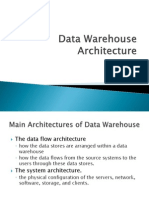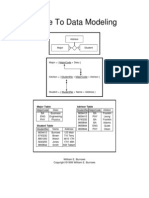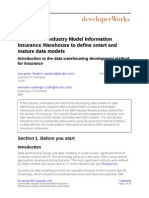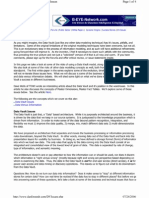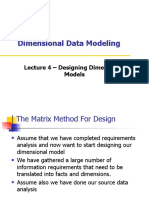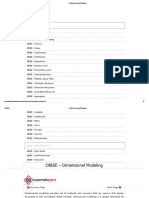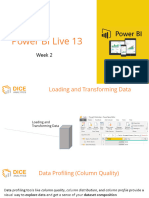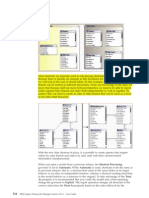Dimensional Modelling by Example
Uploaded by
Feras AlswairkyDimensional Modelling by Example
Uploaded by
Feras AlswairkyDimensional Modelling by Example
Dimensional Modelling by Example
Barry Williams
barryw@databaseanswers.org
Page 1
04/09/2014 13:02
Dimensional Modelling by Example
1. Management Summary ............................................................................................................ 5
1.1 The Purpose of this Book................................................................................................... 5
1.2 The Contents of this Book ................................................................................................. 5
1.3 Three Stages .......................................................................................................................... 5
1.4 What are Dimensional Models ? ..................................................................................... 5
1.5 Data Marts............................................................................................................................... 6
1.6 Best Practice ........................................................................................................................... 7
1.7 Types of Dimensional Models .......................................................................................... 7
1.8 How to use the Dimensional Models ........................................................................... 12
2. Getting Started .......................................................................................................................... 12
2.1 Design Guidelines - a Four-Step Approach .............................................................. 12
2.2 Always use Surrogate Keys ............................................................................................ 12
2.3 Agree an Architecture ....................................................................................................... 13
2.4 Conceptual Data Models .................................................................................................. 18
2.5 Using Dimensional Models for Reports....................................................................... 21
2.6 Dates and Flattened Hierarchies .................................................................................. 22
3. Reaching Maturity ..................................................................................................................... 23
3.1 Semantic Layer ................................................................................................................... 23
3.2 Self-Service BI..................................................................................................................... 25
3.3 Churn - Analysing Churn Rate ....................................................................................... 25
3.4 Promotions Analysing Promotions Effectiveness ................................................ 27
3.5 Conformed Dimensions .................................................................................................... 29
3.6 Systems and Design Patterns ........................................................................................ 30
3.7 Add new Requirements .................................................................................................... 31
4. Keeping Things Ticking Over ................................................................................................ 31
4.1 Governance ........................................................................................................................... 31
Page 2
04/09/2014 13:02
Dimensional Modelling by Example
4.2 Data Quality.......................................................................................................................... 31
4.3 User Involvement ............................................................................................................... 31
Appendix A. Library of Dimensional Models ......................................................................... 32
A.1 Advertising ............................................................................................................................ 32
A.2 Afghanistan Encounters ................................................................................................... 34
A.3 Airline Operations............................................................................................................... 36
A.4 American Studies ............................................................................................................... 38
A.5 Amusement Parks .............................................................................................................. 40
A.6 Anti Money-Laundering .................................................................................................... 42
A.7 Banking Investment ...................................................................................................... 44
A.8 Banking Retail.................................................................................................................. 46
A.9 Boy Scouts ............................................................................................................................ 48
A.10 Clown Registry .................................................................................................................. 50
A.11 Commercial Properties .................................................................................................. 52
A.12 Cruise Ships ....................................................................................................................... 54
A.13 Customers and Car Parts .............................................................................................. 56
A.14 Day at the Olympics ....................................................................................................... 58
A.15 Dog the Bounty Hunter ................................................................................................. 60
A.16 Dog Whisperer .................................................................................................................. 62
A.17 Financial Services ............................................................................................................ 64
A.18 Football ................................................................................................................................ 66
A.19 e-Commerce ..................................................................................................................... 68
A.20 Entertainment ................................................................................................................... 70
A.21 Event Processing .............................................................................................................. 72
A.22 Golf Memorabilia .............................................................................................................. 74
A.23 Gym Training Diaries...................................................................................................... 76
A.24 Hotel Reservations .......................................................................................................... 78
Page 3
04/09/2014 13:02
Dimensional Modelling by Example
A.25 Insurance ............................................................................................................................ 80
A.26 Library Donations ............................................................................................................ 82
A.27 Local Government ........................................................................................................... 84
A.28 Logistics ............................................................................................................................... 86
A.29 Pharmaceutical Companies .......................................................................................... 88
A.30 Pool Hall Management ................................................................................................... 91
A.31 Property Tax Appeal ....................................................................................................... 93
A.32 Public Transport ............................................................................................................... 95
A.33 Puppies Tricks ................................................................................................................... 97
A.34 Radio Stations ................................................................................................................... 99
A.35 Recycling and Garbage Collection ........................................................................... 101
A.36 Restaurant Guides ......................................................................................................... 103
A.37 Retail .................................................................................................................................. 105
A.38 Student Registration ................................................................................................... 107
A.39 Telecomms Companies .............................................................................................. 109
A.40 Tracking Printer Cartridges ........................................................................................ 111
A.41 Traffic Cops and Tickets .............................................................................................. 113
A.42 Travel and Transport .................................................................................................... 115
A.43 Usual Suspects ............................................................................................................... 117
A.44 Utilities ............................................................................................................................... 119
A.45 Vulnerable People .......................................................................................................... 121
A.46 Waste Management ...................................................................................................... 123
A.47 Wedding Parties ............................................................................................................. 125
A.48 Wine .................................................................................................................................... 127
A.49 Yakuza Japanese Organised Crime ..................................................................... 129
A.50 Zoos .................................................................................................................................... 131
Page 4
04/09/2014 13:02
Dimensional Modelling by Example
1. Management Summary
1.1 The Purpose of this Book
The purpose of this book is to offer an introduction to Dimensional Modelling.
It contains some background and theory and a Library of fifty Industry-specific Models to
help you get started in creating something specific to your requirements.
I also teach a Course and provide consulting services based on the contents of his Book.
If you have questions or need help, please feel free to email me.
1.2 The Contents of this Book
The contents of this book include all the major topics of interest in the area of Dimensional
Modelling.
Conformed Dimensions
Fact Tables
Factless Facts
Self-Service BI
Dimension Modelling
Accumulative
Snapshots
Snapshots
Aggregate
Snapshots
1.3 Three Stages
These Topics are covered in three Stages which are covered later in this Book :1. Getting Started
2. Reaching Maturity
3. Keeping Things Ticking Over
1.4 What are Dimensional Models ?
The concept of Dimensional Modelling was developed by Ralph Kimball.in response to a
demand from end-users for an easy way to specify Reports.
This contrasted with the alternative Corporate Information Factory, the vision of
Bill Inmon.
Page 5
04/09/2014 13:02
Dimensional Modelling by Example
This diagram shows a Dimensional Model that Ralph Kimball has published on his Web Site
for a Retail Point of Sales :
http://www.kimballgroup.com/1997/08/02/a-dimensional-modeling-manifesto/
It shows very clearly the approach which can be described very simply as The data that can
be measured are called the Facts and they are stored with the things that can be measured
by, which are called the the Dimensions.
In this simple example. Kimball has kindly given all the Dimensions names ending
Dimensions, and there are three Facts that are called Dollars Sold, Units Sold and Dollars
Cost.
1.5 Data Marts
We use the term Data Mart as an alternative to Dimensional Model.
We consider that they both mean the same but we sometimes use Data Mart in
a way that might include more than one Dimensional Model, especially for a
functional area, such as Sales.
We refer to the majority of our Models as Dimensional Models, but occasionally
we call them Data Marts which we prefer because it is more flexible.
Page 6
04/09/2014 13:02
Dimensional Modelling by Example
1.6 Best Practice
Where appropriate, we consider the Kimball Web Site as our definitive source of
Best Practice in Data Modelling :
http://www.kimballgroup.com/
If you are looking for a good background, this page on Dimensional Modelling
Techniques on the Kimball Web Site is highly recommended :
http://www.kimballgroup.com/data-warehouse-business-intelligenceresources/kimball-techniques/dimensional-modeling-techniques/
Wikipedia is usually worth a look, and here is the entry for Dimensional
Modelling :
http://en.wikipedia.org/wiki/Dimensional_modeling
An excellent writer is Chris Adamson who has published a great book called Star
Schema :
http://www.amazon.com/s/ref=nb_sb_noss/188-67989686571923?url=search-alias%3Daps&fieldkeywords=chris%20adamson%20star%20schema
As a backup reference, we use Discussion Groups in LinkedIn like this one on
DW Dimensional Modelling :
https://www.linkedin.com/groups?gid=1435647&trk=vsrp_groups_res_na
me&trkInfo=VSRPsearchId%3A593656941409771308466%2CVSRPtarget
Id%3A1435647%2CVSRPcmpt%3Aprimary
In LinkedIn, one good thing is that we can ask specific questions if we are
seeking a majority view of Best Practice or Recommended Guidelines.
1.7 Types of Dimensional Models
We can identify five distinct types of Dimensional Models which are discussed below :
Accumulating Snapshot Tables
Aggregate Tables
Fact Tables
Factless Fact Tables
Snapshot Tables
Page 7
04/09/2014 13:02
Dimensional Modelling by Example
1.7.1 Accumulating Snapshot Tables
A common example involves the use of a Stage or Status Dimension which is used to track
progress through the Snapshots.
In the first example, we have added a Stage Dimension and we add records at the
successive Stages of a Passengers progress
1.7.1.1 Airline Example
This example of an Accumulating Snapshot Fact Table for Airline Operations shows how we
can track the progress of a Passenger.
http://www.databaseanswers.org/data_models/airline_operations/accumulating_snapshot.htm
Page 8
04/09/2014 13:02
Dimensional Modelling by Example
1.7.1.2 Student Registration Example
Here we have added a Registration Stage Dimension to help us track registration with the
help of this Accumulating Snapshot.
http://www.databaseanswers.org/data_models/student_registration/accumulating_snapshot.htm
1.7.2 Aggregate Facts
Aggregates are created in response to the requirements of end-users.
For example, Averages, Counts and Totals.
We define these three as default in all our Fact Tables, as well as data for Key Performance
indicators (KPIs). Graphs and Trends
Page 9
04/09/2014 13:02
Dimensional Modelling by Example
1.7.3 Fact Tables
Fact Tables are the most common type and the majority of our Dimensional Models are Fact
Tables.
They store Dimension Data and Fact Data.
1.7.4 Factless Fact Tables
A Factless Fact is one that has no data associated with it. In other words, it has Dimensions
but no Facts.
A common example is an Event, where the occurrence of the Event is itself a Fact.
Such as this Data Mart for Student Registration that we show here.
http://www.databaseanswers.org/data_models/student_registration/student_registration_data_mart_model.htm
Page 10
04/09/2014 13:02
Dimensional Modelling by Example
1.7.5 Snapshot Tables
Snapshot Tables record historic data at periodic intervals, such as Day, Week or
month.
Here we show a Monthly Snapshot for Customers and Car Parts.
http://www.databaseanswers.org/data_models/customers_and_car_parts/monthly_snapshot.htm
Page 11
04/09/2014 13:02
Dimensional Modelling by Example
1.8 How to use the Dimensional Models
In addition to Dimension Models, we have included Entity-Relationship Diagrams,
which we show simply as ERD.
For each ERD we have added a brief description of the Business Rules that define
the Entities or Things of Interest and how they are related.
This is very important because it helps the end-user to understand the kind of
data that is available in a way that is easy and natural to understand.
The first step in applying these Models to your own situation is
Review the Business Rules
Modify the ERD to reflect any changes you make to the Business Rules.
Make the corresponding changes to the Dimensional Models.
2. Getting Started
2.1 Design Guidelines - a Four-Step Approach
Guideline : Follow Plan to establish controlled growth in your dimensional model.
Here is one that is triggered by an Event or a Business Process
1. Establish the users requirements.
2. Determine the grain of the data
3. Identify the Dimensions
4. Identify the Facts
2.2 Always use Surrogate Keys
Guideline : Always use Surrogate Keys for Dimensional Models.
Ralph Kimball (The father of Dimensional Modelling) has published 10 Rules of Dimensional
Modelling.
Number 8 states
Make certain that dimension tables use a surrogate key
He has published a note on Surrogate Keys :
http://www.kimballgroup.com/1998/05/surrogate-keys/
where he states that surrogate keys are essential for joining data in Fact Tables and
Dimension Tables.
In other words, without Surrogate Keys there would be no Dimensional Models.
They are a powerful technique and also offer excellent performance.
Page 12
04/09/2014 13:02
Dimensional Modelling by Example
2.3 Agree an Architecture
This requires consensus on a Layered Data Architecture and Components.
2.3.1 Data Architecture for the Semantic Layer
The Semantic Layer supports Self-service.
This Architecture answers the question :What is the role of the Semantic Layer ?
BI Layer
Semantic Layer (Map technical to business
Terms, Glossary, Report Catalogue, etc.)
Top-Level Data Model
Dimensional Models
/ Data Marts
Data Warehouse
Staging Area
Data Source
Page 13
04/09/2014 13:02
Dimensional Modelling by Example
2.3.2 Subject Areas
Here we discuss the use of Subject Areas as a techniques for designing Dimensional Models.
We take the simple example of Customers, Products and Revenue.
This analysis shows that the three dominant Subject Areas are :1. Customers
2. Products
3. Revenue from Sales of Products to Customers.
Customers
Products
Revenue
The Dimensional Models reflect these three Subject Areas.
Page 14
04/09/2014 13:02
Dimensional Modelling by Example
2.3.3 Conformed Dimensions
Conformed Dimensions are shared between Tables and must have the same values in
order for Data to be retrieved satisfactorily.
For example, date-stamped data in two tables must all be at the same level of
granularity for example, Days, Weeks or Months.
Conformed Dimensions are therefore very important and are frequently Reference Data
(such as Calendars) or Master Data (such as Products).
Ralph Kimball (the father of Dimensional Modelling) has defined 10 Essential Rules : http://www.kimballgroup.com/2009/05/the-10-essential-rules-of-dimensional-modeling/
Rule Nr. 9 states :Create conformed dimensions to integrate data across the enterprise.
Customer
Customer
Daily Snapshot
Conformed
Dimensions
Customer
Products
Product Sales
Daily Snapshot
Addresses
Locations
Revenue
Product Sales
Facts
Page 15
Invoice
Fact
Invoice
Snapshot
Revenue
Monthly
Fact
04/09/2014 13:02
Dimensional Modelling by Example
This diagram shows an example of Conformed Dimensions in a Customer Sales situation.
These are the three Dimensions that are common (ie Conformed) to the two Dimension Models
Customer, Customer Segment and Product.
Customer
Contract Daily
Snapshot
Customer
Segment
Product Sales
Daily Snapshot
Product (MDM)
This diagram shows an example of Conformed Dimensions from the Data Mart from our Day at the
Olympics.
http://www.databaseanswers.org/data_models/a_day_at_the_olympics/data_marts_with_conformed_dimensions.htm
This Data Mart features Conformed Dimensions for Calendar, Customers and Sports.
2.3.4 Dimension Model Template
Dimensional Models are characterised by a Surrogate ID as the Primary Key.
Without Surrogate ID Dimensional Models would not exist.
Page 16
04/09/2014 13:02
Dimensional Modelling by Example
Dimensional Models follow a generic design, based on Dimensions and Facts,
where the dimensions and Facts are listed alphabetically :-
Fact Table Name
Surrogate ID (PK)
Dimension 1 Entity
Dimension 1 (FK)
Dimension 2 (FK)
Dimension 1 (PK)
Dimension 1 Details
Dimension 3 (FK)
More Dimensions
Fact 1
Fact 2
Fact 3
More Facts
Page 17
04/09/2014 13:02
Dimensional Modelling by Example
2.4 Conceptual Data Models
Conceptual Data Models are very important for helping the end-user to
understand the data that is available and the basic relationships.
They complement the Dimensional Models.
Conceptual Model are a very powerful technique to answer the question :What Data is available in the Semantic Layer ?
2.4.1 Conceptual Data Model for Airline Operations
This is specialty designed to be a User-Friendly Model that shows the structure
of the data that is available to support Analytics, Reports and BI requirements.
It can be described as follows :Passengers make Reservations for Scheduled Flights operated by Airlines.
They take Flights and make Payments which generate Revenue.
Airlines
Passengers
Reservations
Scheduled Flights
Flights
Payments
Revenue
Page 18
04/09/2014 13:02
Dimensional Modelling by Example
2.4.2 Conceptual Data Model for a Retail business
This is also specialty designed to be a User-Friendly Model.
This one can be described as follows :Customers go to Stores and purchase Branded Products for which they make
Payments which generate Revenue.
Customers
Brands
Stores
Products
Purchases
Payments
Revenue
Page 19
04/09/2014 13:02
Dimensional Modelling by Example
2.4.3 Top-Level Data Model for a Telecomms business
This one applies to a Telecomms Business and can be described as follows :Customers sign up for Subscriptions and then take out Contracts (or
Agreements) to purchase Products which are made available through Offerings.
They then use Networks which generates Revenue.
Customers
Products
Subscriptions
Offerings
Agreements
Network Usage
Revenue
Page 20
04/09/2014 13:02
Dimensional Modelling by Example
2.5 Using Dimensional Models for Reports
2.5.1 A Data Warehouse for Airport Management
This shows the Data Model for a Data Warehouse.
In this Section, we discuss the Report that can be produced from this Data Warehouse.
http://www.databaseanswers.org/data_models/airport_management/event_driven_data_warehouse.htm
Page 21
04/09/2014 13:02
Dimensional Modelling by Example
2.5.2 A Basic Report
We can produce a count of Aircraft landing by Airline.
2.5.3 Comparing Scheduled against Actual Landings
If we want to produce a Report that compares Scheduled against Actual Landings we add
data from the Flight Schedules Table.
2.6 Dates and Flattened Hierarchies
We normally show Dates as an Entity called Calendar.
Because it is reference data, we name the Entity Ref_Calendar :-
When it is appropriate, we then expand normally show Dates as a Flattened Hierarchy like this :-
Page 22
04/09/2014 13:02
Dimensional Modelling by Example
3. Reaching Maturity
3.1 Semantic Layer
This is a good point at which to consider introducing a Semantic Layer.
The primary purpose of a Semantic Layer (SL) is to translate technical terms to
business terms which are familiar to end-users.
For example, Churn Rate instead of Deactivation Count divided by Customer
Count.
Providing Self-Service BI makes it essential to provide a Semantic Layer.
This diagram shows the Layered Data Architecture that we use as a point of
reference.
This role clarifies the Role of the Semantic Layer.
BI Layer (Analytics,
Dashboards, Reports)
Semantic Layer
(Mapping Business
to Technical Terms
Dimensional Models /
Data Marts
Data Warehouse
Business Objects pioneered the SL concept, and in a Business Objects
environment, a Semantic Layer (SL) can easily be implemented.
Page 23
04/09/2014 13:02
Dimensional Modelling by Example
3.1.1 A Telecomms Semantic Layer
A Semantic Layer for a typical Telecomms business is shown on this page :http://www.databaseanswers.org/data_models/telecomms/components_in_a_semantic_layer.htm
It has three Data Marts :1. Customers
2. Network Activity
3. Revenue
The Customers Data Mart includes Churn data and the Network Activity includes Promotions
data.
We have used this data in the Self-Service BI that we discuss in the next Section.
This shows the Churn Conceptual Model :-
This shows the Promotion Conceptual Model :-
Page 24
04/09/2014 13:02
Dimensional Modelling by Example
3.2 Self-Service BI
Self-Service BI is a facility provided to end-users which allows them to
select the data they want and the Dashboard or Report they would like to
use to see their data displayed.
They can do this without depending on IT.
Here we discuss how Dimensional Models can be used to provide data for
Self-Service BI.
A Semantic Layer is an important part of Self-Service BI.
It includes a Glossary of Terms, a Report Catalogue and a Semantic Layer.
3.3 Churn - Analysing Churn Rate
* http://www.databaseanswers.org/data_models/retail_customers/customers_area_model.htm
it is proposed to set up a small application using a Key Performance Indicator (KPI) to monitor a
Churn Rate.
The KPI will have a defined Threshold value and when this value is reached an Alert will be sent to a
nominated end-user in the form of an email message.
This email can be received on a mobile phone so that the end-user can be playing golf when he
receives the email.
This shows how the principle of Management by Exception can be applied using todays technology.
3.3.1 What is a Churn Rate ?
A Churn Rate is typically calculated as the total number of Deactivations (the Deactivation Count) in
a given period, divided by the total number of Customers (the Customer Count).
Page 25
04/09/2014 13:02
Dimensional Modelling by Example
3.3.2 Specifications
These Specifications will be reviewed and agreed or modified by the end-user.
It is proposed that the Churn Rate will be monitored on a regular basis, such as daily or in real-time.
Step 1) Define KPI and Threshold
Step 2) Define End-User and Email
Step 3) Monitor KPI and send Email
Step 4) User responds to Email
Step 5 User (optionally) Drills Down
The Self-Service supports the steps defined above, including :1. Define Key Performance Indicator as the Churn Rate with a user-specified Threshold value
such as 20%.
2. Define end-user and email address.
3.3.3 The Data
3.3.3.1 Demonstration data
A small set of demonstration data will be created , following this template :Date and Time
KPI Value
Threshold
Value
Red/Amber/Green
Action
09:00 Aug/01/ 2014
10:00 Aug/01/ 2014
11:00 Aug/01/ 2014
11:00 Aug/01/ 2014
5%
10 %
15 %
20 %
20%
20%
20%
20%
Green
Green
Green
Red
Do nothing
Do nothing
Do nothing
Send Email to end-user
3.3.3.2 Drill-down data
If it is decided to provide a drill-down facility, the required data will need to be provided.
Page 26
04/09/2014 13:02
Dimensional Modelling by Example
3.4 Promotions Analysing Promotions Effectiveness
3.4.1 Approach
We use the Layered Data Architecture in Chapter 5 to identify the activities
involved in his Case Study.
This shows the Layered Data Architecture that we use as a point of
reference.se it.
This shows exactly how we use it.
BI Layer Analytics,
Check what data is available.
Dashboards, Reports
Add what is necessary.
Comply with format, content.
Semantic Layer
Mapping Business
to Technical Terms
Dimensional Models
Add what is necessary,
Comply with 2.1.1 Guidelines.
Enhance Data Models,
comply with Governance
Data Warehouse
3.4.2 Purpose
The purpose of this Case Study is to provide a walk-through to show how to solve a specific BI
requirement.
The requirement that we have chosen is to analyse the effectiveness of a Promotion.
3.4.3 Steps
Step 1. Determine the sources of the required data.
Step 2. If it is in the Data Warehouse, then identify the Tables that will be involved.
Step 3. Add Tables where required.
Step 4. If it is not in the Data Warehouse, then identify the Data Sources and ensure good
quality and availability.
Step 5. Identify the Dimensional Models involved.
Step 6. Add Dimensions and Facts where required.
Page 27
04/09/2014 13:02
Dimensional Modelling by Example
3.4.4 Tables in the Data Warehouse
Here we have added a Table called Product Promotion which has a Foreign Key
relationship to the Product Table.
Guidelines : Maintain the design approach of the existing Third-Normal Form Data
Warehouse, with a surrogate ID field for the Primary Key.
Barrys Product Promotion_
Product_Promotion_Id
Product
Product Id
Product Id (FK)
Date_From
Date_To
Product_Price_Percentage_Reduction
Promotion_Description
Promotion_Objectives
Promotion_Achievements
Other_Promotion_Details
Product Name
Product Desc
SAP Offering Id (FK)
SAP Product Id (FK)
Financial Material Id (FK)
3.4.5 Conceptual View of the Product Sales Daily Snapshot
Here we show a User-Friendly version of the Table shown above.
It tells us that we can analyse any of the Facts by any combination of the Dimensions.
In particular, we can analyse sales of products in periods when there was a Promotion and periods
without a Promotion.
Product Sales Daily Snapshot
DIMENSIONS
Contract Status
Contract
Customer
Customer Segment
Customer Type
Date
Month
Product
Promotion
Retail Outlet
Product Brand
Payment Type
Payment Type Group
FACTS
Contract Activation Count
Contract Deactivation Count
Sales Amount
Sales Value
Page 28
04/09/2014 13:02
Dimensional Modelling by Example
3.5 Conformed Dimensions
Here we analyse the Subject Areas and Dimensional Models to analyse common patterns.
This helps us in the very valuable task of determining Conformed Dimensions.
3.5.1 Components for each System
Nr. System A
System B
System C
Comments
1)
2)
Yes
No
Yes
No
Yes
50%
All three say they have a Semantic Layer but none do.
A list of user-friendly terms is available but without
mapping, it is of limited value.
3)
4)
5)
No
No
Yes
No
No
Yes
Yes
No
Yes
Essential for a Semantic Layer
Consistency will be checked
3.5.2 Dimensional Models Consistency
Code
Nr.
System A
CDS
CMS
RMF
RMF
SDS
SPDS
Customer Daily Snapshot
Consumer Monthly Snapshot
Network Usage Daily Snapshot
Revenue Monthly Fact
Subscriptions Daily Snapshot
Subscriptions Product Daily Snapshot
Yes
Yes
System B
System C
Yes
Yes
Yes
Yes
3.5.3 Dimensions
Dimension
Agreement
Business Area
Calendar Date
Consumer
Customer
Customer Activation
Customer Business Area
Customer Demographic Segment
Customer Segment
Customer Segment Hierarchy
Customer Type
Location
Revenue Segment
Product
Contract
Contract Brand
Contract Business Area
Contract Customer
Yes
Yes
Yes
Yes
Yes
Yes
Yes
Yes
Yes
Yes
Yes
Yes
Yes
Yes
Yes
Yes
Yes
Yes
Yes
Snowflake
Yes
Yes
Yes
Yes
Yes
Yes
Page 29
Yes
Yes
Yes
Yes
04/09/2014 13:02
Dimensional Modelling by Example
Contract
Contract
Contract
Contract
Payment Type
Segment
Type Group
Type Offering
Yes
Yes
Yes
Yes
3.6 Systems and Design Patterns
Here we review the commonality among the three Systems A,B and C.
Specifically we look at the Conceptual Model and the corresponding ERD.
This contributes to establishing a Single View of the Truth.
3.6.1.2 Mapping System A to Conceptual Model
This shows how System A shown above maps to our Top-Level Conceptual Model in Section A.1 in
this Appendix.
The matching Entities are shown in light blue.
Brands
Customers
Subscriptions
Products
Contracts
Product Usage
Revenue (Invoice)
Page 30
04/09/2014 13:02
Dimensional Modelling by Example
3.7 Add new Requirements
This contributes to establishing a Single View of the Truth.
Review the Conceptual Model and the corresponding ERD.
4. Keeping Things Ticking Over
4.1 Governance
It is time to consider Governance now that a stable state has been reached,
where users are receiving standard off-the-shelf Reports and a thriving SelfService user community is able to meet its own demands for Reports and
analytics.
This will involve appointing Data Stewards with assigned responsibilities.
For example, Scripts for creating Dimensional Models with sign-off from a
designated individual, and for checking values for a Single View of the Truth
from the Data Warehouse.
4.2 Data Quality
This includes Profiling and Referential Integrity.
If the Data Warehouse is considered to hold good quality data then it might still
be appropriate to consider putting in place some minimal checks.
For example, checking the min and max for Agreement start and end dates can
be done (relatively) quickly and with simple SQL Scripts.
4.3 User Involvement
At this stage, an active user community should exist and frequent meetings
should take place between users and IT.
The role of IT should include monitoring user activity and advising on situations
that might represent an unacceptable load on a Server.
Page 31
04/09/2014 13:02
Dimensional Modelling by Example
Appendix A. Library of Dimensional Models
In this Appendix, we list Data Models for fifty different Industry Sectors.
We have included links to the Data Models on our Database Answers Web Site :http://www.databaseanswers.org/data_models/index.htm
A.1 Advertising
A.1.1 ERD
http://www.databaseanswers.org/data_models/advertising_systems/index.htm
Page 32
04/09/2014 13:02
Dimensional Modelling by Example
A.1.2 Business Rules
1. Advertisements are placed by Agencies.
2. Advertisements are placed by Channels, such as TV or Print.
3. Advertisements can be part of a Marketing Campaign.
4. Invoices are produced and result in Payments.
5. Advertisements result in Responses.
6. Responses can be analysed by Demographics.
A.1.3 Dimensional Model
http://www.databaseanswers.org/data_models/advertising_systems/advertising_systems_data_mart.htm
Page 33
04/09/2014 13:02
Dimensional Modelling by Example
A.2 Afghanistan Encounters
A.2.1 ERD
http://www.databaseanswers.org/data_models/afghanistan_encounters/index.htm
Page 34
04/09/2014 13:02
Dimensional Modelling by Example
A.2.2 Business Rules
1. The System records details of Afghans and their encounters with the Military.
2. It also records details of links between Afghans and Terrorist Organisations.
3. It also records details of Afghans, their Associates and Meetings with Associates.
A.2.3 Dimensional Model
http://www.databaseanswers.org/data_models/afghanistan_encounters/data_mart.htm
Page 35
04/09/2014 13:02
Dimensional Modelling by Example
A.3 Airline Operations
A.3.1 ERD
This Data Model adopts an Event-oriented Approach that is based on our Canonical Data Model :http://www.databaseanswers.org/data_models/canon_data_models/index.htm
The ERD is on this page :http://www.databaseanswers.org/data_models/airline_operations/index.htm
A.3.2 Business Rules
1. The System records Customer Events involved in Airline Operations.
2. The first Event is that the Customer Makes a Reservation.
3. Then the Customer Checks In, Boards an Aircraft and is then In Flight.
4. Finally, the Customer Disembarks.
This Event-Oriented approach is very flexible.
This starting-point can be extended horizontally i.e. more Customer-related detailed
Events, or Horizontally, to include more details of the events already recorded.
Page 36
04/09/2014 13:02
Dimensional Modelling by Example
A.3.3 Dimensional Model
http://www.databaseanswers.org/data_models/airline_operations/dimensional_model.htm
Page 37
04/09/2014 13:02
Dimensional Modelling by Example
A.4 American Studies
A.4.1 ERD
http://www.databaseanswers.org/data_models/american_studies/index.htm
A.4.2 Business Rules
1. Topics are taught by Teaching Institutions at a number of Places..
2. People sign up to Study Topics.
3. A range of Topics are available, that share an overall structure, shown by the Inheritance
Relationship and the Study Topics Super-Type.
4. Each topic can also have some characteristics that are specific to itself.
They are called Children or Sub-Types of the Inheritance Relationship.
Page 38
04/09/2014 13:02
Dimensional Modelling by Example
A.4.3 Dimensional Model
http://www.databaseanswers.org/data_models/american_studies/data_mart.htm
Page 39
04/09/2014 13:02
Dimensional Modelling by Example
A.5 Amusement Parks
A.5.1 ERD
http://www.databaseanswers.org/data_models/amusement_parks/index.htm
A.5.2 Business Rules
1. Rides are available.
2. Customers use Credit or Debit Cards to buy Tickets to Ride.
3. Staff operate the Rides.
4. Staff also work on Maintenance Schedules for the Rides.
Page 40
04/09/2014 13:02
Dimensional Modelling by Example
A.5.3 Dimensional Model
http://www.databaseanswers.org/data_models/amusement_parks/data_mart.htm
Page 41
04/09/2014 13:02
Dimensional Modelling by Example
A.6 Anti Money-Laundering
A.6.1 ERD
http://www.databaseanswers.org/data_models/anti_money_laundering/index.htm
A.6.2 Business Rules
1. People have Associates.
2. Organisations have Associates.
3. People are involved with Organisations.
4. People and Organisations engage in Transactions that involve Accounts.
5. They play specific Roles in these Transactions.
Page 42
04/09/2014 13:02
Dimensional Modelling by Example
A.6.3 Dimensional Model
http://www.databaseanswers.org/data_models/anti_money_laundering/data_mart.htm
Page 43
04/09/2014 13:02
Dimensional Modelling by Example
A.7 Banking Investment
A.7.1 ERD for General Deals
http://www.databaseanswers.org/data_models/investment_banking/deals_general.htm
A.7.2 Business Rules
1. The focus of this Model is Deals.
2. Deals involve Customers and Staff
3. Deals generate Accounting Entries.
4. Deals result in Settlements from Deals.
5. The Deal General table stores details that are common to all Deals.
6. A Deal is of a particular Deal Type and separate tables hold details for FX Deals,
Financial Instrument Deals and so on.
Page 44
04/09/2014 13:02
Dimensional Modelling by Example
A.7.3 Dimensional Model
This is an example of a Data Mart for FX Deals.
http://www.databaseanswers.org/data_models/investment_banking/poc_fx_Deals_data_warehouse.htm
Page 45
04/09/2014 13:02
Dimensional Modelling by Example
A.8 Banking Retail
A.8.1 ERD
http://www.databaseanswers.org/data_models/retail_banks/top_level_data_model.htm
A.8.2 Business Rules
1. Banks operate Branches.
2. Banks and Branches have Addresses
3. Branches have Customers
4. Customers have Accounts.
5. Transactions take place on these Accounts.
Page 46
04/09/2014 13:02
Dimensional Modelling by Example
A.8.3 Dimensional Model
http://www.databaseanswers.org/data_models/retail_banks/top_level_data_model.htm
This Model features Conformed Dimensions for Accounts, Account Types and Calendar.
Page 47
04/09/2014 13:02
Dimensional Modelling by Example
A.9 Boy Scouts
A.9.1 ERD
http://www.databaseanswers.org/data_models/boy_scouts/index.htm
A.9.2 Business Rules
1. Scouts are young people who are usually associated with an Adult.
2. Scouts can achieve Awards.
3. Scouts make Attendance at Events.
4. Scouts can choose Elective activities.
Page 48
04/09/2014 13:02
Dimensional Modelling by Example
A.9.3 Dimensional Model
http://www.databaseanswers.org/data_models/boy_scouts/dimensional_model.htm
Page 49
04/09/2014 13:02
Dimensional Modelling by Example
A.10 Clown Registry
A.10.1 ERD
http://www.databaseanswers.org/data_models/clown_registry/index.htm
A.10.2 Business Rules
1. People registered as Clowns are stored in the Clowns Table.
2. A Clown can have Acts with specific Features.
3. Clowns accept Bookings to perform at specific Locations for specific Customers.
Page 50
04/09/2014 13:02
Dimensional Modelling by Example
A.10.3 Dimensional Model
http://www.databaseanswers.org/data_models/clown_registry/clown_data_mart.htm
Page 51
04/09/2014 13:02
Dimensional Modelling by Example
A.11 Commercial Properties
A.11.1 ERD
http://www.databaseanswers.org/data_models/commercial_properties/index.htm
A.11.2 Business Rules
1. Properties are Industrial or Retail.
2. Properties are at Locations.
3. Properties have a range of Property Features.
4. Properties are owned by Companies.
5. Real Estate Agents have Clients.
6. Clients sign up for Client Service Contracts involving Properties.
7. A Contract can involve a number of Transactions.
.
Page 52
04/09/2014 13:02
Dimensional Modelling by Example
A.11.3 Dimensional Model
http://www.databaseanswers.org/data_models/commercial_properties/dimensional_model.htm
Page 53
04/09/2014 13:02
Dimensional Modelling by Example
A.12 Cruise Ships
A.12.1 ERD
http://www.databaseanswers.org/data_models/cruise_ships/index.htm
A.12.2 Business Rules
1. Ships offer Cruises.
2. Staff are employed on Cruises.
3. Passengers buy Tickets for Cruises.
4. Passengers are allocated Places on Cruises.
Page 54
04/09/2014 13:02
Dimensional Modelling by Example
A.12.3 Dimensional Model
http://www.databaseanswers.org/data_models/cruise_ships/data_mart.htm
Page 55
04/09/2014 13:02
Dimensional Modelling by Example
A.13 Customers and Car Parts
A.13.1 ERD
http://www.databaseanswers.org/data_models/customers_and_car_parts/index.htm
A.13.2 Business Rules
1. Customers place Orders.
2. Orders contain one or many Parts.
3. Parts are specific to Brands.
4. Parts are ordered from Suppliers
5. Parts are available for Cars.
Page 56
04/09/2014 13:02
Dimensional Modelling by Example
A.13.3 Dimensional Model
http://www.databaseanswers.org/data_models/customers_and_car_parts/dimensional_model_pragmatic_style.htm
In this Dimensional Model, we have adopted the style recommended by a very active
Microsoft Partner called Pragmatic Works, based In Florida.
As you can see, their standard has Dimension Tables prefixed by Dim and Fact table
prefixed by Facts.
Page 57
04/09/2014 13:02
Dimensional Modelling by Example
A.14 Day at the Olympics
A.14.1 ERD
http://www.databaseanswers.org/data_models/a_day_at_the_olympics/index.htm
A.14.2 Business Rules
1. Our Day at the Olympics involved a number of Events.
2. The first Event was to Find my Seat in the competition hall.
3. The second Event was to Have Lunch.
4. The third Event was to Watch the Judo Competition.
We show an Inheritance Relationship with an Events Super-Type and the three SubTypes.
Page 58
04/09/2014 13:02
Dimensional Modelling by Example
A.14.3 Dimensional Model
http://www.databaseanswers.org/data_models/a_day_at_the_olympics/data_marts_with_conformed_dimensions.htm
This Model features Conformed Dimensions for Calendar, Customers and Sports.
Page 59
04/09/2014 13:02
Dimensional Modelling by Example
A.15 Dog the Bounty Hunter
A.15.1 ERD
http://www.databaseanswers.org/data_models/dog_the_bounty_hunter/index.htm
A.15.2 Business Rules
1. The Bounty Hunter is involved in Catching Fugitives.
2. Fugitives have Associates who play specific Roles.
3. A number of Individuals are involved in Catching Fugitives.
These Individuals are usually members of Dogs family.
4. Activities of Catching Fugitives are frequently the subject of TV Recordings.
5. TV Recordings become TV Recording Sales to TV companies around the world.
Page 60
04/09/2014 13:02
Dimensional Modelling by Example
A.15.3 Dimensional Model
http://www.databaseanswers.org/data_models/dog_the_bounty_hunter/dimensional_model.htm
If you want to see a larger size Model, just click on the link above.
Page 61
04/09/2014 13:02
Dimensional Modelling by Example
A.16 Dog Whisperer
A.16.1 ERD
http://www.databaseanswers.org/data_models/dog_whisperer/index.htm
A.16.2 Business Rules
1. The Dog Whisperer specialises in handling Dogs with Dog Problems.
2. Dogs are of specific Breeds.
3. Dogs have a specific State of Mind.
4. Dogs are diagnosed with one or many Problems.
5. Each Problem has possible Problem Treatments.
6. The Dog Whisperer uses some or all of these Treatments for a specific Dog.
7. Dogs belong to Clients.
8. The Dog Whisperer makes one or many visits to each Client.
9. These Visits and Dog Treatment can be made subjects of TV Recording.
10. TV Recordings become TV Recording Sales to TV companies around the world.
Page 62
04/09/2014 13:02
Dimensional Modelling by Example
A.16.3 Dimensional Model
http://www.databaseanswers.org/data_models/dog_whisperer/dimensional_model.htm
If you want to see a larger size Model, just click on the link above.
Page 63
04/09/2014 13:02
Dimensional Modelling by Example
A.17 Financial Services
A.17.1 ERD
http://www.databaseanswers.org/data_models/customers_and_financial_services/index.htm
A.17.2 Business Rules
1. Suppliers offer Products.
2. Products are either Banking or Insurance Products.
3. Banking Products can be either Retail or Investment.
4. Insurance Products can be either for Car, Home, Life or Pets.
5. Products are involved in Events.
6. These Events will always involve Customers.
7. They may also involve Locations and Staff.
8. Events might also involve Payments.
9. Events might also involve Documents.
10. Documents can be either Bank Statements or Insurance Policies.
Page 64
04/09/2014 13:02
Dimensional Modelling by Example
A.17.3 Dimensional Model
http://www.databaseanswers.org/data_models/customers_and_financial_services/dimensional_model.htm
Page 65
04/09/2014 13:02
Dimensional Modelling by Example
A.18 Football
A.18.1 ERD
We were pleased to find that our designs apply to both American Football (the
NFL) and Soccer (Football in the UK and elsewhere outside the US).
http://www.databaseanswers.org/data_models/football_clubs/index.htm
A.18.2 Business Rules
1. Football Clubs play Games.
2. Football Clubs have specific Uniforms
3. Football Clubs have specific Jargon, such a Fumble in the NFL..
4. Football Clubs have a range of Reference Material, such as Footballer Contracts.
Page 66
04/09/2014 13:02
Dimensional Modelling by Example
5. Games always involve two Football Clubs.
6. Games are played at Locations.
7. Games always produce Deliverables such as Goals and Results.
8. Football Clubs have Cub Personnel, including Players.
9. Players are involved in Games as Game Players.
10. Players in Games can play at specific Positions.
11. Games can involve Value Systems, such as Play by the Rules and Win.
A.18.3 Dimensional Model
http://www.databaseanswers.org/data_models/football_clubs/dimensional_model.htm
Page 67
04/09/2014 13:02
Dimensional Modelling by Example
A.19 e-Commerce
A.19.1 ERD
http://www.databaseanswers.org/data_models/e_commerce_shopping_carts/top_level_model.htm
Page 68
04/09/2014 13:02
Dimensional Modelling by Example
A.19.2 Business Rules
1. Customers may have one or many Shopping Carts.
2. A Customer may have zero or one Wish List.
3. Customers may have one or many Payment Methods available.
4. A Shipping Cart can contain one or many Order Items.
5. Order Items are delivered in Shipments.
6. An Invoice is generated for each Shipment.
7. Customers make Payments for Invoices using a Payment Method.
A.19.3 Dimensional Model
http://www.databaseanswers.org/data_models/e_commerce_shopping_carts/dimensional_model.htm
Page 69
04/09/2014 13:02
Dimensional Modelling by Example
A.20 Entertainment
A.20.1 ERD
http://www.databaseanswers.org/data_models/entertainment_top_level/index.htm
A.20.2 Business Rules
1. Suppliers put on Performances.
2. Performances can be either Music Festivals, Sports or Theater Shows.
3. These are Sub-Types of the Performances Super-Type and Inherit the Super-Type
characteristics.
4. Customers can make Performances Bookings at specific Locations.
5. Staff are involved in making these Performances Bookings.
6. Tickets are issued for Performances Bookings.
Page 70
04/09/2014 13:02
Dimensional Modelling by Example
A.20.3 Dimensional Model
http://www.databaseanswers.org/data_models/entertainment_top_level/dimensional_model.htm
Page 71
04/09/2014 13:02
Dimensional Modelling by Example
A.21 Event Processing
A.21.1 ERD
http://www.databaseanswers.org/data_models/complex_event_processing/index.htm
A.21.2 Business Rules
1. Events can involve zero, one or many People.
2. Events can occur in specific Patterns.
3. Patterns of Events are in specific Business Categories.
4. People can be involved in Actions and Events.
5. A People can play specific Roles in Actions and Events
6. Alerts are always associated with people.
Page 72
04/09/2014 13:02
Dimensional Modelling by Example
A.21.3 Dimensional Model
http://www.databaseanswers.org/data_models/complex_event_processing/dimensional_model.htm
Page 73
04/09/2014 13:02
Dimensional Modelling by Example
A.22 Golf Memorabilia
A.22.1 ERD
http://www.databaseanswers.org/data_models/golf_memorabilia/index.htm
Page 74
04/09/2014 13:02
Dimensional Modelling by Example
A.22.2 Business Rules
1. Memorabilia is associated with either Famous People, such as Tiger Woods, or Famous
Places, such as Pebble Beach.
2. Memorabilia Items can be in three major Memorabilia Types :* Golf Balls
* Golf Clubs
* Pottery, which has three Sub-categories
* Mugs
* Plates
* Steins
A.22.3 Dimensional Model
http://www.databaseanswers.org/data_models/golf_memorabilia/dimensional_model.htm
Page 75
04/09/2014 13:02
Dimensional Modelling by Example
A.23 Gym Training Diaries
A.23.1 ERD
http://www.databaseanswers.org/data_models/gym_training_diary/index.htm
Page 76
04/09/2014 13:02
Dimensional Modelling by Example
A.23.2 Business Rules
1. The My Profile table records details of an individuals personal details.
2. Entries in a Training Diary reflect the Training Schedules for an individual.
3. Exercises are recorded in the Training Diary.
4. Entries in a Training Diary also reflect the Level of Training, e.g. Beginner or Advanced.
5. Assessments are made at regular intervals to determine progress towards an individuals
Targets and Goals.
6.A Diet may be drawn up for an Individual.
7.A Diet is made up of specific Diet Items.
8. Measurements are made at dated intervals to record Targets and Goals and
Measurement details.
9. Details of Sessions are recorded in the Sessions Table.
10. A Diary is kept of other non-training details.
11. Logs are kept to log other details.
A.23.3 Dimensional Model
http://www.databaseanswers.org/data_models/gym_training_diary/data_mart.htm
Page 77
04/09/2014 13:02
Dimensional Modelling by Example
A.24 Hotel Reservations
A.24.1 ERD
http://www.databaseanswers.org/data_models/hotels/index.htm
This Model is created in Erwin which allows us to define Many-to-Many Relationships.
For example, we have defined a Many-to-Many between Hotels and Hotel Characteristics.
This means that a Hotel can have many Characteristics (such as a Gym and Internet access) and the
same Characteristics can be found in many Hotels.
Page 78
04/09/2014 13:02
Dimensional Modelling by Example
A.24.2 Business Rules
1. Hotels might (or might not) be in a Hotel Chain
2. Each Hotel is in a specific Country
3. Each Hotel has a Star Rating.
4. A Hotel can have many Characteristics (such as a Gym and Internet access).
5. A Characteristic can be found in many Hotels.
6. Hotels have a number of Hotel Rooms of designated Types.
7. Each Room Type has a Rate that applies for a specified Period of time.
8. Guests make Bookings
9. Bookings become Specific Room Bookings later, usually when Guests arrive at a Hotel.
A.24.3 Dimensional Model
http://www.databaseanswers.org/data_models/hotels/revenue_data_mart.htm
Page 79
04/09/2014 13:02
Dimensional Modelling by Example
A.25 Insurance
A.25.1 ERD
http://www.databaseanswers.org/data_models/insurance_policies_and_claims/index.htm
Page 80
04/09/2014 13:02
Dimensional Modelling by Example
A.25.2 Business Rules
1. Customers take out Policies for a specific period of time.
2. Each Policy is of a defined Policy Type, such as Car, Home or Life.
3.Claims can be made on each Policy.
4.A Claim goes through a series of Claims Processing Stages.
5. This might involve Employees, who might process Claims Documents.
6. Each Stage will have a Stage Outcome, such as Disputed, In Progress or Settled.
A.25.3 Dimensional Model
http://www.databaseanswers.org/data_models/insurance_policies_and_claims/claims_dimensional_model.htm
Page 81
04/09/2014 13:02
Dimensional Modelling by Example
A.26 Library Donations
A.26.1 ERD
http://www.databaseanswers.org/data_models/library_donations/index.htm
A.26.2 Business Rules
1. Donations are made by Donors to Libraries.
2. Donations are used to make Book Purchases from Sellers.
3. Every Book is of a specific Book Genre.
4. The Donations in Purchases table keeps track of the specific Books that are purchased by
each Donation.
Page 82
04/09/2014 13:02
Dimensional Modelling by Example
A.26.3 Dimensional Model
http://www.databaseanswers.org/data_models/library_donations/library_donations_data_mart.htm
Page 83
04/09/2014 13:02
Dimensional Modelling by Example
A.27 Local Government
A.27.1 ERD Model
http://www.databaseanswers.org/data_models/enterprise_data_model_for_local_government/top_level_model.htm
A.27.2 Business Rules
1.The important focus here is Citizens.
2. Citizens have Addresses.
3. Citizens become Customers when they receive Services.
4. Services are a Super-Type with Education and Housing as examples of Sub-Types,
Page 84
04/09/2014 13:02
Dimensional Modelling by Example
A.27.3 Dimensional Model
http://www.databaseanswers.org/data_models/enterprise_data_model_for_local_government/data_mart.htm
Page 85
04/09/2014 13:02
Dimensional Modelling by Example
A.28 Logistics
A.28.1 ERD Model
http://www.databaseanswers.org/data_models/logistics_and_shipments/index.htm
A.28.2 Business Rules
1. Customers place Orders.
2. Orders are delivered as Shipments.
3. Shipments are associated with Locations.
4. A Shipment contains one or many Products.
5. A Shipment consists of one or many Shipment Legs.
6. A Shipment Leg is associated with Shipment Leg Documents.
7. Shipment Leg Documents are of Standard Document Types, such as Bills of Lading and
Delivery Notes.
Page 86
04/09/2014 13:02
Dimensional Modelling by Example
A.28.3 Dimensional Model
http://www.databaseanswers.org/data_models/logistics_and_shipments/dimensional_model.htm
Page 87
04/09/2014 13:02
Dimensional Modelling by Example
A.29 Pharmaceutical Companies
A.29.1 ERD Model
http://www.databaseanswers.org/data_models/pharmaceutical_companies/index.htm
A.29.2 Business Rules
1. Pharmaceutical Companies manufacture Products in Factories.
2. Manufactured Products and Products from Suppliers are stored in Warehouses at specific
Locations.
3. Products are then delivered to Retail Outlets according to Delivery Schedules using
Delivery Vehicles.
4. Customers then go to Retail Outlets to purchase Products.
In summary, we can say Pharmaceutical Companies manufacture Products in Factories
that they store in Warehouses and that they deliver to Retail Outlets for Customers to
Purchase.
Page 88
04/09/2014 13:02
Dimensional Modelling by Example
A.29.3 Dimensional Model
http://www.databaseanswers.org/data_models/pharmaceutical_companies/dimensional_model.htm
Page 89
04/09/2014 13:02
Dimensional Modelling by Example
A.29.4 Alternative Dimensional Model
http://www.databaseanswers.org/data_models/pharmaceuticals_dw/index.htm
This is a simpler Data Warehouse for Pharmaceutical Sales.
It shows the common Dimensions of Customers, Products and Sales.
It would be very valuable for you to go through the steps of progressing from this basic
Model to the one shown above.
If you would like my comments on your work please feel free to email me at
barryw@databaseanswers.org.
Page 90
04/09/2014 13:02
Dimensional Modelling by Example
A.30 Pool Hall Management
A.30.1 ERD Model
http://www.databaseanswers.org/data_models/pool_hall_management/index.htm
A.30.2 Business Rules
1. Customers play at a Pool Hall.
2. They can be either Commercial or Personal Customers.
3. They can make Regular Bookings.
4. They book Tables by the hour.
5. They make Payments (or receive refunds) which are Financial Transactions using
Payment Methods.
Page 91
04/09/2014 13:02
Dimensional Modelling by Example
A.30.3 Dimensional Model
http://www.databaseanswers.org/data_models/pool_hall_management/data_mart.htm
Page 92
04/09/2014 13:02
Dimensional Modelling by Example
A.31 Property Tax Appeal
A.31.1 ERD Model
http://www.databaseanswers.org/data_models/property_tax_appeals/index.htm
A.31.2 Business Rules
1. Clients are involved in Matters that require assistance from Attorneys.
2. These Matters relate to Parcels of land in specific Counties.
3. Clients make Appeals about these Parcels.
4. Every Appeal has an Outcome
5. Every Appeal involves a range of Documents of specified Types.
Page 93
04/09/2014 13:02
Dimensional Modelling by Example
A.31.3 Dimensional Model
http://www.databaseanswers.org/data_models/property_tax_appeals/data_mart.htm
Page 94
04/09/2014 13:02
Dimensional Modelling by Example
A.32 Public Transport
A.32.1 ERD Model
http://www.databaseanswers.org/data_models/public_transport/index.htm
A.32.2 Business Rules
1. Passengers make Itinerary Bookings.
2. Payments are made for Bookings.
3. An Itinerary Booking can involve Itinerary Legs which are made up of Legs.
4. Timetables are published by Transport Operators
5. Timetables include Legs of planned Schedules.
6. Timetable Prices are also published.
7. Prices depend on Passenger Categories and Ticket Types.
Page 95
04/09/2014 13:02
Dimensional Modelling by Example
A.32.3 Dimensional Model
http://www.databaseanswers.org/data_models/public_transport/public_transport_data_mart.htm
Page 96
04/09/2014 13:02
Dimensional Modelling by Example
A.33 Puppies Tricks
A.33.1 ERD Model
http://www.databaseanswers.org/data_models/puppies_tricks/index.htm
A.33.2 Business Rules
1. Puppies can do Tricks.
2. Puppies learn Tricks in Kennels.
3. Tricks are performed at specific Skill Levels.
4. Typical Skill Levels are Beginners, Intermediate and Advanced.
Page 97
04/09/2014 13:02
Dimensional Modelling by Example
A.33.3 Dimensional Model
http://www.databaseanswers.org/data_models/puppies_tricks/dimensional_model.htm
Page 98
04/09/2014 13:02
Dimensional Modelling by Example
A.34 Radio Stations
A.34.1 ERD Model
http://www.databaseanswers.org/data_models/radio_stations/index.htm
A.34.2 Business Rules
1. Radio Stations broadcast Music of specific genres.
2. The music can be CD Tracks and MP3 Tracks.
3. Playlists are maintained that determine the music to be played.
4. Information is maintained about Artists, the Artists on CDs and Artists on specific Tracks.
5. Schedules are maintained with Disk Jockeys allocated to Schedules.
6. Music is broadcast according to Scheduled Playlists
Page 99
04/09/2014 13:02
Dimensional Modelling by Example
A.34.3 Dimensional Model
http://www.databaseanswers.org/data_models/radio_stations/radio_stations_data_mart.htm
Page 100
04/09/2014 13:02
Dimensional Modelling by Example
A.35 Recycling and Garbage Collection
A.35.1 ERD Model
http://www.databaseanswers.org/data_models/recycling_and_garbage_collection/index.htm
A.35.2 Business Rules
1. Local Authorities are responsible for the cleanliness of Streets.
2. Properties are on Streets and may or may not have Wheelie Bins.
3. Collection Schedules are maintained for the Collection of Garbage from Properties.
4.Street Collections are made in accordance with the Collection Schedules.
5. Each Street Collection has a Status, e.g. Missed, Successful.
6. A record is maintained of the Amount Collected of each Recycling Category, such as
Clothes, Glass or Paper.
Page 101
04/09/2014 13:02
Dimensional Modelling by Example
A.35.3 Dimensional Model
http://www.databaseanswers.org/data_models/recycling_and_garbage_collection/index.htm
Page 102
04/09/2014 13:02
Dimensional Modelling by Example
A.36 Restaurant Guides
A.36.1 ERD Model
http://www.databaseanswers.org/data_models/restaurant_guide/index.htm
A.36.2 Business Rules
1. Details of Restaurants are published in Guides.
2. These details include the Addess and the Type of Food served,
3. Visitors Comments are recorded, including Star Gradings.
4. Visitors are placed in Visitor Categories, such as Family on Vacation.
Page 103
04/09/2014 13:02
Dimensional Modelling by Example
A.36.3 Dimensional Model
http://www.databaseanswers.org/data_models/restaurant_guide/data_mart.htm
Page 104
04/09/2014 13:02
Dimensional Modelling by Example
A.37 Retail
A.37.1 ERD Model
http://www.databaseanswers.org/data_models/retail_customers/customers_area_model.htm
A.37.2 Business Rules
1. Customer demographics include Countries, Customer Categories and Gender.
2. Customers place Orders.
3. Orders involve Shipments that deliver goods to Customers.
4. Shopping Carts are used to hold Customers goods.
5. Mailshot Campaigns target specific Mailshot Customers
6. Customers choose Customer Payment Methods from a standard list of Payment Methods.
Page 105
04/09/2014 13:02
Dimensional Modelling by Example
A.37.3 Dimensional Model
http://www.databaseanswers.org/data_models/retail_customers/retail_dimensional_model.htm
Page 106
04/09/2014 13:02
Dimensional Modelling by Example
A.38 Student Registration
A.38.1 ERD
http://www.databaseanswers.org/data_models/student_registration/index.htm
A.38.2 Business Rules
1. Students register for Classes.
2. Students have Addresses of specific Address Types, such as Home or Local Address.
3. Students can have Parents or Guardians.
4. Students can choose from a list of standard Payment Methods.
Page 107
04/09/2014 13:02
Dimensional Modelling by Example
A.38.3 Dimensional Model
http://www.databaseanswers.org/data_models/student_registration/student_registration_data_mart_model.htm
Page 108
04/09/2014 13:02
Dimensional Modelling by Example
A.39 Telecomms Companies
A.39.1 ERD
http://www.databaseanswers.org/data_models/telecomms/index.htm
A.39.2 Business Rules
1. Telecomms Services are provided by Telecomms Suppliers to Customers.
2. Events occur that supply these Services.
3. These Events might also involve Documents and Staff.
4. Staff have Job Titles.
Page 109
04/09/2014 13:02
Dimensional Modelling by Example
A.39.3 Dimensional Model
http://www.databaseanswers.org/data_models/telecomms/conformed_dimensions_data_mart.htm
This Model features Conformed Dimensions for Calendar, Locations, Phone Calls and Phone Numbers.
Page 110
04/09/2014 13:02
Dimensional Modelling by Example
A.40 Tracking Printer Cartridges
A.40.1 ERD
http://www.databaseanswers.org/data_models/tracking_printer_cartridges/index.htm
A.40.2 Business Rules
1. Cartridge Manufacturers produce Printer Cartridges.
2. Printer Manufacturers produce Printers.
3. Printers are placed at specific Locations.
4. Cartridges are handled in Printer Cartridge Batches.
5. Users make Requests for assistance with Printers at specific Locations.
6. A Cartridge Inventory is maintained at dated intervals.
7. Re-Order Frequencies are defined for Printer Cartridges.
8. Technicians install Cartridges in Printers.
Page 111
04/09/2014 13:02
Dimensional Modelling by Example
A.40.3 Dimensional Model
This Data Model shows Keys without any data attributes.
http://www.databaseanswers.org/data_models/tracking_printer_cartridges/data_mart.htm
Page 112
04/09/2014 13:02
Dimensional Modelling by Example
A.41 Traffic Cops and Tickets
A.41.1 ERD
http://www.databaseanswers.org/data_models/traffic_cops_and_tickets/index.htm
A.41.2 Business Rules
1. Officers issue Tickets for Violations.
2. Each Ticket has a Status, such as Cancelled, Issued or Paid.
3. A Violation always involves a Document, such as a Ticket.
4. Tickets are issued in relation to Violations Vehicles belonging to Violaters
Page 113
04/09/2014 13:02
Dimensional Modelling by Example
A.41.3 Dimensional Model
http://www.databaseanswers.org/data_models/traffic_cops_and_tickets/law_enforcement_data_mart.htm
Page 114
04/09/2014 13:02
Dimensional Modelling by Example
A.42 Travel and Transport
A.42.1 ERD Model
http://www.databaseanswers.org/data_models/travel_and_transport_top_level/index.htm
A.42.2 Business Rules
1. Suppliers provide Services to Customers.
2. These Services can include Cargo Shipments and Passenger Journies.
3. Customers can make Requests for Services at specific Locations.
4. Staff might be involved, for example in supplying Documents or receiving Payments.
5. Documents can be Delivery Notes or Tickets.
Page 115
04/09/2014 13:02
Dimensional Modelling by Example
A.42.3 Dimensional Model
http://www.databaseanswers.org/data_models/travel_and_transport_top_level/dimensional_model.htm
Page 116
04/09/2014 13:02
Dimensional Modelling by Example
A.43 Usual Suspects
A.43.1 ERD Model
http://www.databaseanswers.org/data_models/usual_suspects/index.htm
Page 117
04/09/2014 13:02
Dimensional Modelling by Example
A.43.2 Business Rules
1. The Usual Suspects get involved in Situations.
2. Deliverables result from the Situations and can include Football Goals ,Touchdowns or
Legal Decisions.
3. The Usual Suspects wear Uniforms that reflect their Roles.
4. They follow Tribal Customs and use Jargon.
5. Their Situations involve Reference Material, such as Contracts or Legal Precedents.
6. Events are associated with Tribal Customs and reflect Value Systems.
7. Value Systems can be Materialistic Goals, Objectives, Religious Principles and so on.
A.43.3 Dimensional Model
http://www.databaseanswers.org/data_models/usual_suspects/data_mart.htm
Page 118
04/09/2014 13:02
Dimensional Modelling by Example
A.44 Utilities
A.44.1 ERD Model
http://www.databaseanswers.org/data_models/utilities/index.htm
A.44.2 Business Rules
1. Utilities companies offer Services (eg Gas and Electricity) that they Deliver to Customers.
2. These Services usually involve Delivery over a widespread Geographic area.
3. Customers take out Contracts for these Services.
4. Meters measure how much Customers use of the Services
5. Customers make Payments for the amount they use.
6. Events occur in the Delivery of the Services, such as checking and maintenance of the
Services.
Page 119
04/09/2014 13:02
Dimensional Modelling by Example
A.44.3 Dimensional Model
http://www.databaseanswers.org/data_models/utilitiess/data_mart.htm
Page 120
04/09/2014 13:02
Dimensional Modelling by Example
A.45 Vulnerable People
A.45.1 ERD Model
http://www.databaseanswers.org/data_models/vulnerable_people/index.htm
A.45.2 Business Rules
1. Vulnerable People might have Carers.
2. They might live in special Accommodation.
3. They can have one or many Vulnerabilities of specified Types.
4. Vulnerabilities have Treatments.
5. The Effectiveness is recorded of Treatment for specific Vulnerabilities for specific People.
Page 121
04/09/2014 13:02
Dimensional Modelling by Example
A.45.3 Dimensional Model
http://www.databaseanswers.org/data_models/vulnerable_people/data_mart.htm
Page 122
04/09/2014 13:02
Dimensional Modelling by Example
A.46 Waste Management
A.46.1 ERD Model
http://www.databaseanswers.org/data_models/waste_management/index.htm
A.46.2 Business Rules
1. Hospitals generate Waste.
2. Hospitals can belong to Hospital Systems.
3. Hospitals maintain Contacts and a Contacts History.
4. Waste Profiles are maintained and Waste Generated is compared to Profiles.
5. Waste Profiles involve Container and Waste Locations.
Page 123
04/09/2014 13:02
Dimensional Modelling by Example
A.46.3 Dimensional Model
http://www.databaseanswers.org/data_models/waste_management/dimension_model.htm
Page 124
04/09/2014 13:02
Dimensional Modelling by Example
A.47 Wedding Parties
A.47.1 ERD Model
http://www.databaseanswers.org/data_models/wedding_parties/index.htm
This is based on our Usual Suspects Model which is described above in Section A.44.
A.47.2 Business Rules
1. Wedding Parties involve Outfits, Participants and Etiquette.
2. They include Jargon, such as Bride and Groom.
3. They also involve Deliverables, such as Wedding Videos.
4 Events can include Value Systems, such as Follow Wedding Etiquette.
5. Wedding Etiquette involves Events, such as Limousine Booking and Receptions
Page 125
04/09/2014 13:02
Dimensional Modelling by Example
A.47.3 Dimensional Model
http://www.databaseanswers.org/data_models/wedding_parties/wedding_parties_data_mart.htm
Page 126
04/09/2014 13:02
Dimensional Modelling by Example
A.48 Wine
A.48.1 ERD Model
http://www.databaseanswers.org/data_models/wine_lists/index.htm
A.48.2 Business Rules
1. Wines are defined by a number of characteristics, including Grape Variety, Year,
Vineyard, Color, Country and Region .
Page 127
04/09/2014 13:02
Dimensional Modelling by Example
A.48.3 Dimensional Model
http://www.databaseanswers.org/data_models/wine_lists/dimensional_model.htm
Page 128
04/09/2014 13:02
Dimensional Modelling by Example
A.49 Yakuza Japanese Organised Crime
A.49.1 ERD
http://www.databaseanswers.org/data_models/yakuza_japanese_crime/index.htm
A.49.2 Business Rules
1. The Yakuza is an organisation which consists of Principal Clans that contain Members.
2. Yakuza is organized in a Hierarchy with four Levels.
,
Page 129
04/09/2014 13:02
Dimensional Modelling by Example
A.49.3 Dimensional Model
http://www.databaseanswers.org/data_models/yakuza_japanese_crime/dimensional_model.htm
Page 130
04/09/2014 13:02
Dimensional Modelling by Example
A.50 Zoos
A.50.1 ERD
http://www.databaseanswers.org/data_models/zoos/index.htm
A.50.2 Business Rules
1. A Zoo contains Animals of specific Breeds.
2. Each Breed has its own Dietary Requirements which define Food Items in Categories.
3. Dietary Requirements for specific Animals in the Zoo are derived from these Food Items.
4. Check-ups are carried out on the Animals.
Page 131
04/09/2014 13:02
Dimensional Modelling by Example
A.50.3 Dimensional Model
http://www.databaseanswers.org/data_models/zoos/dimensional_model.htm
Page 132
04/09/2014 13:02
You might also like
- Dimensional Modeling in Data WarehousingNo ratings yetDimensional Modeling in Data Warehousing23 pages
- Dimensional Modeling in Data WarehousingNo ratings yetDimensional Modeling in Data Warehousing7 pages
- Data Modeling and Database Design: Minder Chen, Ph.D. Mchen@gmu - Edu100% (1)Data Modeling and Database Design: Minder Chen, Ph.D. Mchen@gmu - Edu150 pages
- Conceptual Data Modeling and Database Design Volume 1 - The Shortest Advisable Path A Fully Algorithmic Approach50% (2)Conceptual Data Modeling and Database Design Volume 1 - The Shortest Advisable Path A Fully Algorithmic Approach662 pages
- Data Warehouse - Concept and Fundamentals: SrideviNo ratings yetData Warehouse - Concept and Fundamentals: Sridevi25 pages
- Star Schema and Technology Review: Musa Sami Ata Abdel-Rahman Supervisor: Professor Sebastian LinkNo ratings yetStar Schema and Technology Review: Musa Sami Ata Abdel-Rahman Supervisor: Professor Sebastian Link15 pages
- What Is Data Architecture - A Framework For Managing Data - CIONo ratings yetWhat Is Data Architecture - A Framework For Managing Data - CIO6 pages
- Minder Chen, Ph.D. Mchen@gmu - Edu: Member Is A Member of100% (1)Minder Chen, Ph.D. Mchen@gmu - Edu: Member Is A Member of150 pages
- Modul 9 - Data Warehousing and Business Intelligence - DMBOK2No ratings yetModul 9 - Data Warehousing and Business Intelligence - DMBOK259 pages
- DAMA-Reference Logical Data Models For Agile BINo ratings yetDAMA-Reference Logical Data Models For Agile BI21 pages
- Maharishi Markandeshwar (Deemed To Be University), Mullana (Ambala)No ratings yetMaharishi Markandeshwar (Deemed To Be University), Mullana (Ambala)18 pages
- Redbook - Master Data Management With InfosphereNo ratings yetRedbook - Master Data Management With Infosphere596 pages
- OBM Level I OBM Level II Obm Level Iii Application Category Process Analysis QuestionsNo ratings yetOBM Level I OBM Level II Obm Level Iii Application Category Process Analysis Questions24 pages
- Instructions 18802097 Gatherstats Recon FS SIL 11.1.1.7.1No ratings yetInstructions 18802097 Gatherstats Recon FS SIL 11.1.1.7.13 pages
- Data Warehouse Dimensional Modeling - HolowczakNo ratings yetData Warehouse Dimensional Modeling - Holowczak5 pages
- Exercise Solutions: For TDWI Data ModelingNo ratings yetExercise Solutions: For TDWI Data Modeling8 pages
- Data Warehousing Basics Interview QuestionsNo ratings yetData Warehousing Basics Interview Questions24 pages
- The Microsoft Data Warehouse Toolkit With SQL Server 2008 R2 and The Microsoft Business Intelligence Toolset 2nd Edition Edition Kimball Download100% (1)The Microsoft Data Warehouse Toolkit With SQL Server 2008 R2 and The Microsoft Business Intelligence Toolset 2nd Edition Edition Kimball Download62 pages
- SECCION - IBM Cognos Framework Manager User GuideNo ratings yetSECCION - IBM Cognos Framework Manager User Guide21 pages
- Dimensional Modeling and Schemas: Data Modeling Research PaperNo ratings yetDimensional Modeling and Schemas: Data Modeling Research Paper11 pages





